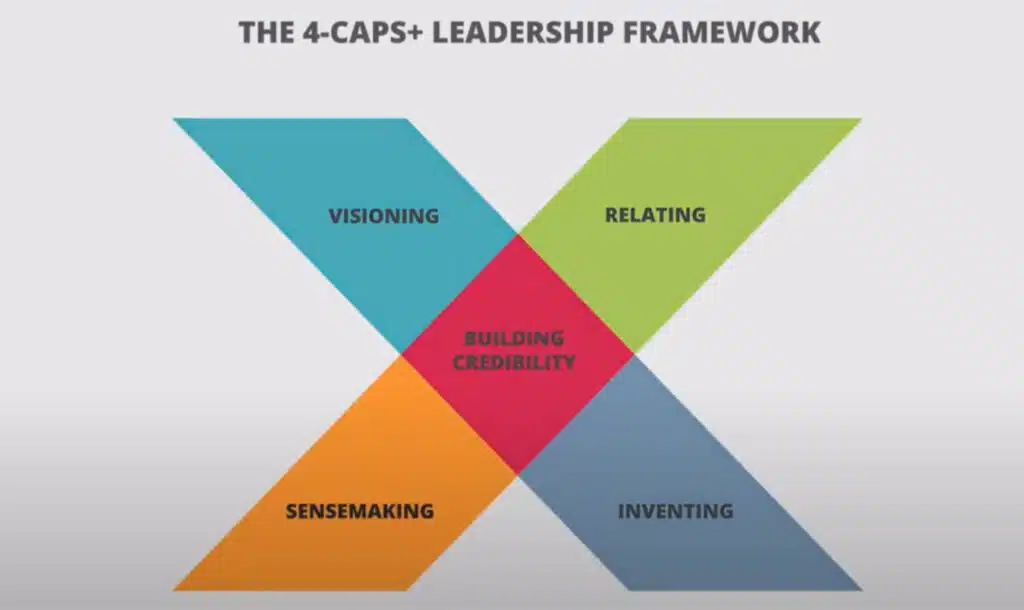While briefly considering taking an online short course at MIT Sloan, Leadership in an Exponentially Changing World, I realized that any course of action taking by leadership during times of great volatility, uncertainty, complexity, and ambiguity (known as VUCA) comes at a risk. But what got me curious was the word ‘inventing’ in MIT Sloan’s framework on leadership. What was it doing there?
MIT Sloan proposes the 4-CAPS+ leadership framework, developed by Professor Ancona and her MIT colleagues, Thomas Malone, Wanda Orlikowski, and Peter Senge to help leadership in making the right decisions when time is short, information scarce, and disruption lurking around the corner.
Let’s have a quick look at their framework:

The 4CAPS+ framework consists of four aspects:
- Visioning
- Relating
- Inventing
- Sensemaking
It has a joined aspect in the middle: Building Credibility.
The key to this framework is Credibility.
Again, the aspect Inventing made me curious. Surely, they are mistaking?
To understand its use, let’s compare the 4-CAPS+ framework to the four essential roles of leadership by FranklinCovey:
- Inspire Trust
- Create Vision
- Execute Strategy
- Coach Potential
The goal of this framework is ‘to develop who a leader is as well as what a leader does.’
The key to this framework is Trust.
Inspire Trust: “Leaders can inspire trust by accelerating their credibility and shape culture from the inside out. Their personal credibility determines how others see them, interact with them, and ultimately trust them.”
Create Vision: “When leaders create vision, they move from managing people to a job description to engaging their team in meaningful work.”
Execute Strategy: “A great system is aligned to achieve what’s most important and makes it easier to get work done. Effective systems operate independently of the leader and endures beyond them.”
Coach Potential: “Effective leaders develop the leadership potential in others and improve performance through consistent feedback and coaching. When leaders coach potential, they move from solving problems by telling others what to do to developing other leaders and building team members’ capacity.”
And let’s add a third framework, described by Stephen Covey as the four imperatives of leadership (2004):
- Inspire Trust
- Clarify Purpose
- Align Systems
- Unleashed Talent
The key to this framework is Unleashed Talent.
“When you inspire trust and share a common purpose with aligned systems, you empower people. Their talent is unleashed so that their capacity, their intelligence, their creativity, and their resourcefulness is utilized.”
Another one worth mentioning, mainly because of its clarity: 4 Essential Roles of Every Career Journey:
- Do (Players)
- Direct (Managers)
- Inquire (Coaches)
- Inspire (Leaders)
What I like about this framework is that it mentions Inquiry as a source of wisdom, while other framework seem to expect a leader to fabricate a vision for the future from thin air.
Comparison
As you can see, all leadership frameworks play a similar chord. When we use the Vision, Strategy, Purpose, and Mission framework, we value each of these minor variations.
However, Stephen Covey’s framework seems to lack the vision part. That should not come as a big surprise as Michael Hyatt, author of The Vision Driven Leader, found that the majority of leaders lack a compelling vision. It’s an “essential ingredient for successful leadership,” that is hardly taught at business schools.
So, what about inventing? It is a role of leadership to create a culture and facilitate an environment in which creativity and innovation can thrive. Especially during times of VUCA, leaders may be forced to favor the innovative capacity and the firm’s readiness for change over continuity and consistency. Inventing, in my opinion, could therefore be seen as the ruling strategic direction.
What's at the Core?
While each framework places something in the heart, be it credibility, trust, or talent, others believe it is purpose or values. We’ve concluded that it is best described as the Positive Core, a term coined by David Cooperrider in 1987: the sum of strengths, including credibility, capabilities, culture, values, skills, unique systems, successful strategies, etc.
Know when to Turn
While leadership plays a critical role in setting the tone (creating vision, inspiring trust, coaching people, and executing the strategy), management must keep the orchestra in tune (planning, organizing, leading, and controlling).
Knowing when to turn depends on the information management captures and passes on, allowing leadership to ‘make sense’ of it all and determine when the firm needs to change its course.
In ROUNDMAP, management needs to maintain and administer the health of four lifecycles to manage the risk of the course of action while keeping an eye on the long-term goals and objectives:
- Business Carousel (= Business Model/Plan)
- Product Carousel (= Product Development)
- Customer Carousel (= Customer Development)
- Growth Carousel (= Growth Plan, including the Learning Cycle)
When any of these lifecycles stalls or contracts, these are triggers for making the turn.
For instance, you may need to turn your ship around when a sector transitions from as-a-product to as-a-service business models, as with Netflix versus Blockbuster. Or, when fewer customers return, you may need to revisit your retention strategy, consider the competition, or revisit your offering.
X marks the Spot
To visualize the strategy, people often use the analogy of a treasure map with an X to mark the spot where the treasure is hidden. Sadly this isn’t what strategy is about. If ever there was a spot, it would likely not stay in its place because of changing conditions.
Instead of ‘marking the spot,’ imagine a relative position in the marketplace that gives you the best starting position. And then, ask yourself the question: What needs to exist for this place to benefit us and our clients?























